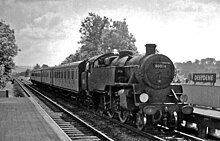(Both pics copyright Steve Sainsbury/Rail Thing Leadhills 1990)
The closest I've ever lived to a heritage line was during my five years living in Leadhills, Scotland. Leadhills in Lanarkshire is Scotland's second highest village, the highest, Wanlockhead in Dumfries and Galloway, is just over a mile away.
Until 1938 both villages were served by a light railway that linked them to the West Coast main line at Elvanfoot. As its name suggests Leadhills had several lead mines, as did Wanlockhead. There were also small quantities of gold in the local streams. The railway allowed passengers to join and alight from the trains at any point.
At between 1400 and 1500 feet above sea level both villages tend to get a lot of snow in winter, in fact it proved almost impossible to photograph the line in winter without there being snow on the ground!
Many years after the line closed a group was formed to build a 2 foot gauge line between the two villages. Progress has been slow thanks to the line crossing the county boundary, and at the moment the track stops in a bleak cutting exactly on the border between Lanarkshire and Dumfriesshire. Dumfries does support the line and the plan is to eventually connect to Wanlockhead and its fantastic Museum of Lead Mining. There were many other narrow gauge tramways in the hills, if you know where to look there is still some gtrack in situ, and there was even a funicular in the biggest mine, which took miners to the lower shafts.
As well as the railway closing the villages themselves were the subject of a closure order in the 1960s, and were in danger of being evacuated and abandoned. Luckily that didn't happen and both villages are now thriving and fascinating places! The line opens at weekends in the summer and a trip should be combined with a trip to the museum, and even a spot of goldpanning.
The
Leadhills and Wanlockhead Light Railway was a short branch railway built to serve mining settlements, high in the
Lowther Hills, connecting them to the Carlisle - Carstairs main line. The line was opened in 1901 - 1902, and was the highest standard gauge railway line in the British Isles. Hoped-for developments did not emerge, and when the world lead price slumped in the 1920s, the line sustained heavy losses. It was closed at the end of 1938.
History

System map of the Leadhills and Wanlockhead Light Railway
The
Light Railways Act 1896 was introduced to encourage the cheap construction of railways that were likely to be lightly used, by permitting some of the former requirements for new railway construction to be omitted.
Lead had been mined in the wild terrain at Leadhills since the eighteenth century; it was carted to Leith Harbour via Biggar over the poor roads of the period. 80% of Scotland's output came from the area. In 1845 a narrow gauge tramway was built between Meadowfoot, about 3 miles (4 km) west of Wanlockhead to bring the lead ore (
Galena) up to Wanlockhead for smelting. Other mines and a washery at Leadhills were also connected.
Local promoters saw that a railway connection to the main line would encourage the mining activity, and possibly also stimulate the establishment of a health resort there.
The Leadhills and Wanlockhead Light Railway obtained its authorising light railway order on 5 August 1898, to make a branch from Elvanfoot, on the main line of the Caledonian Railway. The line opened as far as Leadhills on 1 October 1901 and was extended to Wanlockhead on 1 October 1902. It was worked by the Caledonian Railway.
Lead mining traffic was carried, but was never as extensive as hoped, and the health-seeking visitor traffic was scant: the line dragged on with a very thinly patronised train service for less than 40 years. The Wanlockhead Mining Company went into liquidation in 1936, following a slump in world lead prices after
World War I, and the viability of the line was finished.
The line closed to passenger traffic on 31 December 1938, and to goods shortly afterwards.
The line[edit]
When the line opened as far as Leadhills, that station was the highest in Scotland and the following year Wanlockhead took that accolade, at 1,498 feet (457 m) above sea level. The line was the highest standard gauge line in the British Isles, and also the highest adhesion-worked line. The altitude at Elvanfoot is 922 feet (281 m) and the length of the line was 7¼ miles (11.7 km); the average gradient was 1 in 42.
The only stations were Elvanfoot, the junction station on the main line, and Leadhills and Wanlockhead. The passenger stations did not have raised platforms, and the passenger carriages had three levels of step board which folded down to enable passengers to board. The Caledonian Railway worked the line, and no 172, an 0-4-4T was used in the early years. The trains were mixed (passenger and goods) and the maximum speed was 20 mph (32 km/h).

Rispin Cleugh viaduct shortly before being demolished, 11 November 1990
A significant structure on the line was Rispin Cleugh viaduct, built by
Sir Robert McAlpine & Co. It was built from
concrete and was clad with
terracotta bricks to improve its appearance. It was demolished with explosives in 1991.
The tramway referred to was intersected by the railway when it was built, and there was a flat crossing a short distance north of Leadhills station, where the tramway led to a washery.
Reuse


























































